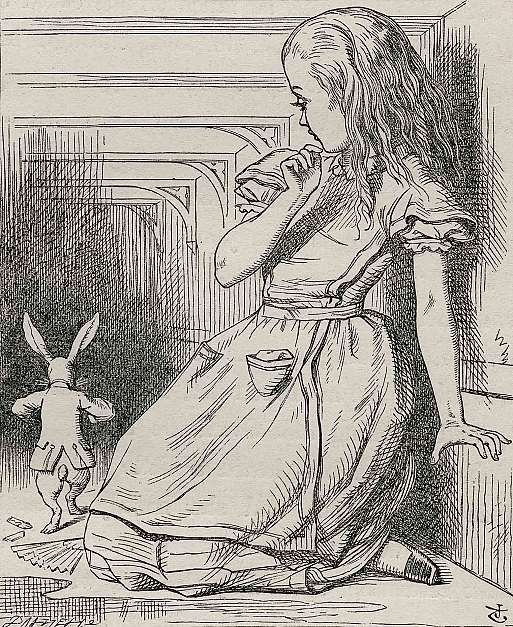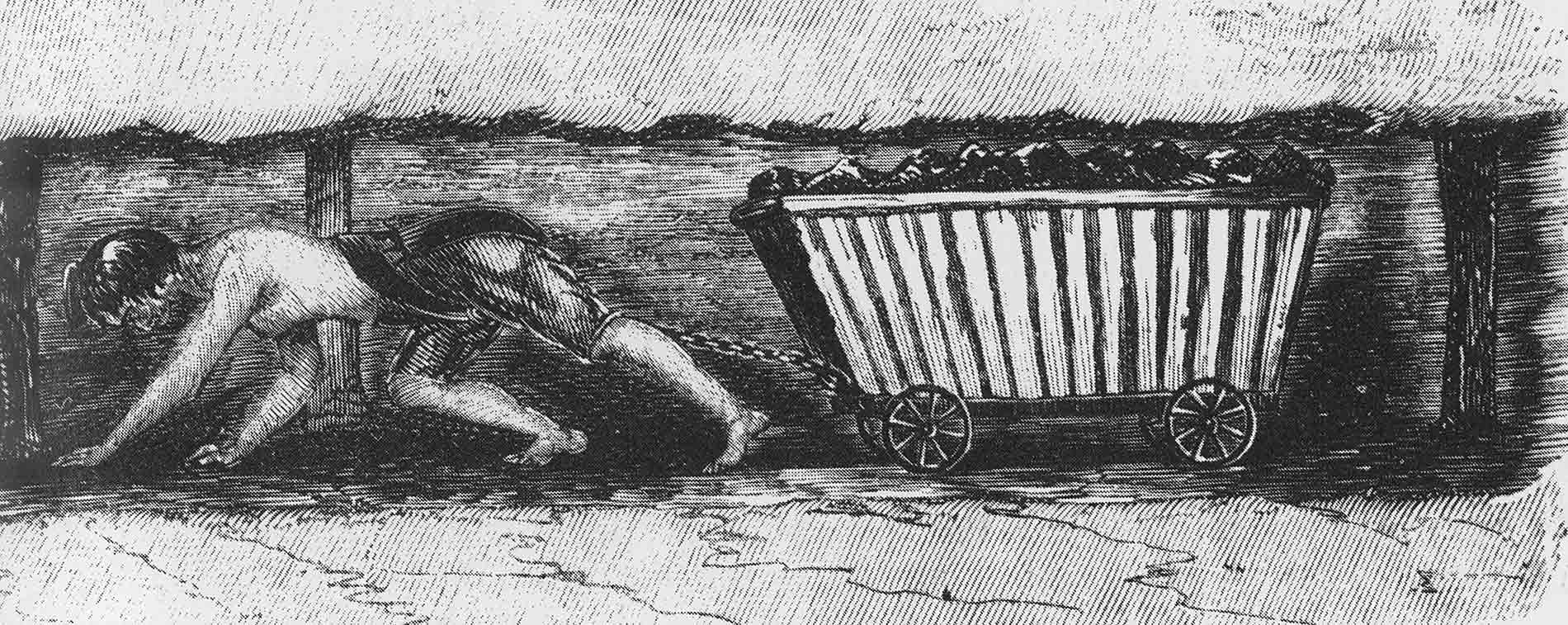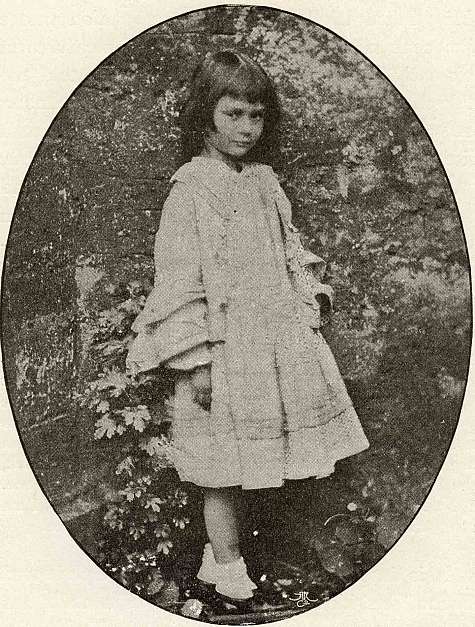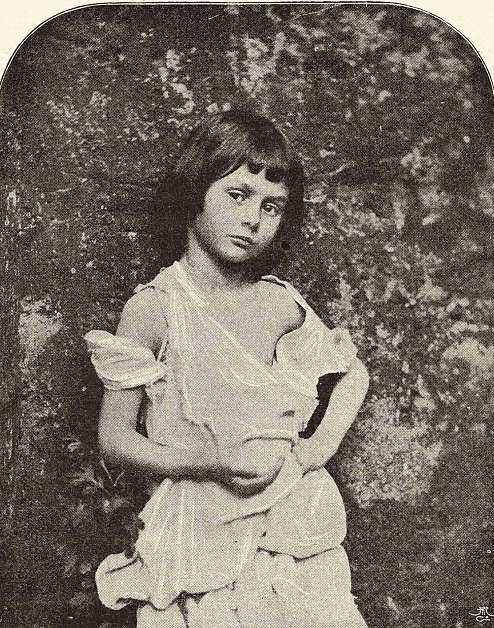The Age of Alice: Fairy Tales, Fantasy, and Nonsense in Victorian England
Alice and the Question of Victorian Childhood
By Lydia Murdoch
“‘Who in the world am I?’ Ah, that’s the great puzzle!”[1] So reflects Alice after she has fallen down the rabbit hole and changed size, first “shutting up like a telescope” until she is only ten inches high, and then “opening out like the largest telescope that ever was,” prompting her to ponder disassociated thoughts of mailing boots to her feet by postal carrier.[2] Literary scholars have identified the existential themes of identity in Lewis Carroll’s Alice’s Adventures in Wonderland (1865), but the question “Who in the world am I?” applied much more broadly to Victorian childhood overall.[3] From the beginning of Queen Victoria’s reign in 1837 to her death in 1901, what it meant to be a child transformed dramatically—a process that Alice’s Adventures in Wonderland both marked and took in new directions by presenting a fresh example of active, questioning girlhood.
The first lines of Carroll’s story identify Alice as a particular class of child—one who, unlike most mid-Victorian children, spent her days in leisure and education. “Alice was beginning to get very tired of sitting by her sister on the bank and of having nothing to do,” wrote Carroll. She initiates her adventures after dismissing the book her sister was reading “without pictures or conversations” as utterly uninteresting. Alice’s Adventures, published just five years before the 1870 Education Act introduced a national system of elementary schools for all children, is filled with earnest lessons reworked into nonsensical jabber. Again and again, seeking to find meaning in the disorderly world below, Alice turns to her memorized drills, only to have them fail her. After questioning her identity, she sets out to “try if I know all the things I used to know,” starting first with the multiplication tables—“four times five is twelve, and four times six is thirteen, and four times seven is—oh dear!”—and then moving on to geography: “London is the capital of Paris, and Paris is the capital of Rome, and Rome—no, that’s all wrong, I’m certain! I must have been changed for Mabel!”[5] Yet even amidst all this confusion, Alice never loses sight of her class bearings. She proudly tells the Mock Turtle that she attends a day school with lessons in French and music, and when he asks whether she studies washing, too, she indignantly replies, “Certainly not!”[6]

Victorian ideals of childhood thus remained contingent on class identity, but Alice’s puzzlements in Wonderland also mirrored earlier debates from the 1830s and 1840s over child workers in British factories and mines. Child labor was by no means new to nineteenth-century industrial Britain. In the early eighteenth century, Daniel Defoe celebrated children as young as four working in emerging textile cottage industries.[7] By the 1830s, however, increasing numbers of reformers presented the harsh discipline, physical demands, and long hours of industrial labor as incompatible with the physical, emotional, and moral needs of young children. The Factory Act of 1833, passed the year after Carroll’s birth, banned all children under nine from working in textile mills and limited working hours of youths between the ages of nine and thirteen to a mere forty-eight hours per week. The following decade, the Mines and Collieries Act of 1842 prohibited all children under ten—as well as all females—from working underground. For Victorian readers, John Tenniel’s illustration of an oversized Alice crouched in the underground hallway wet with the pool of tears would have likely evoked the confinement, isolation, and endangerment of child miners (figure 1). The widely read and reproduced First Report of the Children’s Employment Commission (1842) included stark drawings of other children who had not fallen down the rabbit hole, but been lowered down the mine shaft by adults. The most provocative image from the 1842 Report showed a young girl, naked to the waist and barefoot, crawling on all fours, the chain between her legs attached to the cart of coal that she pulled through the wet narrow passageway (figure 2). While these paired images approached the question of childhood from very different perspectives, they both revealed worlds in which the very spaces and demands placed on children proved incompatible with their needs.

Alice’s reliance on school drills to check her ever-changing identity also mirrors the 1842 Report, in which parliamentary investigators applied the test of knowledge to evaluate the effects of hard labor on child development. Most of the child workers interviewed for the Report had never attended school, or only a Sunday school. Their recorded answers to the interviewers’ questions sound strikingly similar to Alice’s nonsensical attempts to recall her lessons. “I don’t know who Jesus Christ is,” said thirteen-year-old Charles Bayley, “they don’t teach me that; they teach me spelling. I can’t spell horse.” Fifteen-year-old Bessy Bailey claimed, “22 pence is 3 shillings and 1 pence. I don’t know how many weeks there are in the year. I don’t know what Ireland is, whether it is a town or a country.” Another youth said, “I don’t know which is the largest town in England, but I know Wakefield and Leeds.” A sixteen-year-old Yorkshire hurrier declared, “I never heard mention of France. I never heard mention of Wales or of Scotland; but I know people that come from Ireland. I think Ireland is a town as big as Barnsley, where there is plenty of potatoes, and lots of bullocks.” He continued, displaying a great aptitude for monetary calculations (as many of the children did), but little understanding of abstract mathematics: “20 pence is 1 shilling and 8 pence; 32 pence is 2 shillings and 8 pence; 7 times 3 is 32—no, it’s 22.” Twelve-year-old Isaac Bearer was a jumble of contradictions: “I have learnt religion pretty well. I don’t know who Jesus Christ was: I never heard of him. I’ve learnt the Church Catechism: but I don’t know it all. I don’t know what is the largest town in England. Three time[s] ten is twenty.”[8] Highly selective in their questioning, the parliamentary investigators compiled hundreds of statements of evidence such as these to reinforce the point that workers as young as six who spent most of their lives underground were not allowed to become children. Stunted in their growth, harnessed like animals, and ignorant of basic religious and civic knowledge, child workers defied the ideals of domesticity and childhood that were becoming so central to middle-class identity by the beginning of Queen Victoria’s reign and thus legitimated intervention and protections from the otherwise laissez-faire government.
The early sociologist, playwright, and co-founder of Punch Henry Mayhew (1812-1887) developed these themes from the parliamentary reports in his studies of street workers. He began this work as a series of articles in the Morning Chronicle (1849) and eventually expanded and published the four-volume collection as London Labour and the London Poor (1861-1862). Like the authors of the parliamentary Report on mining, Mayhew highlighted what he understood to be the failures of education for working-class children. Now using dialect, Mayhew recounted one child street vendor as saying “he had heer’d of Shakespeare, but didn’t know whether he was alive or dead, and didn’t care. . . Had seen the Queen, but didn’t recollec’ her name just at the minute; oh! yes, Wictoria and Albert.”[9] Mayhew also associated the ideal of childhood with play—a key theme picked up by Carroll. Play increasingly distinguished children from adults, though Mayhew asserted that children of the urban working poor had neither the time nor the spaces for healthy entertainments. In his description of an eight-year-old girl street seller of watercresses, he wrote that she “had entirely lost all childish ways, and was, indeed, in thoughts and manner, a woman.” Language fails, as Mayhew struggled even to talk with her, noting, “At first I treated her as a child, speaking on childish subjects.” When he asked the girl about toys and games, she could only offer a “look of amazement,” and when he talked to her of parks, “she replied in wonder, ‘where are they?’” Mayhew concluded, “All her knowledge seemed to begin and end with watercresses, and what they fetched.”[10]
While Mayhew and the parliamentary reports on child workers presented education, not wage labor, as the proper realm of early childhood, Carroll underscored how didactic instruction soon to be extended to working-class children could work against the very forms of play and fantasy celebrated in Wonderland as essential aspects of childhood. Carroll did this most pointedly in his rewriting of the hymns and poems of Isaac Watts (1674-1748), the Independent minister whose Divine Songs for Children (1715) were still frequently sung and memorized by Victorian youth. Watts stressed children’s inherent sinfulness along with the dangers of sloth and disobedience. One of his hymns urged children to offer “Praise to God for learning to read,” for studying the Bible was how the child came to learn “The Danger I was in, / By Nature and by Practice too / A wretched Slave to Sin.”[11] Among the many parodies in Alice, Carroll rewrote Watts’s moralistic piece “Against Idleness and Mischief” as “How doth the little crocodile / Improve his shining tail, / And pour the waters of the Nile / On every golden scale!,” leaving Alice to conclude, “I’m sure those are not the right words.”[12] Later in the book, Alice finds again that “the words came very queer indeed” as she recites another parody of Watts as “‘Tis the voice of the Lobster: I heard him declare.” Watts’s original poem began “‘Tis the Voice of the Sluggard,” and ended with the sort of clear message that always alludes Alice in Wonderland:
I made him a Visit, still hoping to find
He had took better care for improving his Mind:
He told me his Dreams, talk’d of eating and drinking,
But he scarce reads his Bible, and never loves thinking.Said I then to my Heart, Here’s a Lesson for me,
That Man’s but the Picture of what I might be:
But thanks to my Friends for their care in my Breeding:
Who taught be betimes to love Working and Reading.[13]

Drawing on the Romantics, Carroll rejected Watts’s overwhelming emphasis on the innate sinfulness and corruption of all children. Instead of condemning child idleness, Alice’s Adventures in Wonderland revels in the imagined worlds of fantasy and play that might open up when the books at hand provided no immediate use.
In many ways, however, Carroll’s approaches to childhood remained fixed to the class imaginings of his time. For example, his photographs from the summer of 1858 of Alice Liddell, the real-life muse for Alice’s Adventures, contrast the young girl posed alternatively “Dressed in Her Best” and as “The Beggar Maid” (figures 3 and 4). Carroll, like many other early photographers of children, such as Julia Margaret Cameron (1815-1879), often photographed his child sitters in costume. The paired images of Alice Liddell show how class identities continued to shape ideals of childhood. When posed “Dressed in her Best,” Alice Liddell looks small and childlike, backed against the wall and literally still contained within the garden. “The Beggar Maid,” however, takes its title and staging from Lord Alfred Tennyson’s famous 1842 poem to depict a very different image of eroticized childhood, again recalling the imagery from the 1842 Report on mining. Here Alice looks larger, more adult. Her ragged clothes expose her chest and legs. Her hand-on-hip stance, cupped hand waiting for money, and gathered dress give her the appearance of more woman than child as she seems to step out of the frame with one foot, the other crushing the nasturtium leaves below.[14]

Alice’s Adventures in Wonderland marks the shift in Victorian ideals of childhood from work, discipline, and essential sinfulness to education, play, and innocence, however fleeting. The character of Alice also represents a real recognition of child agency, particularly in response to the Queen’s death threat. “‘Who cares for you?’ said Alice (she had grown to her full size by this time). ‘You’re nothing but a pack of cards!”[15] Yet like all ideals of childhood, Alice’s Adventures reveals as much if not more about adults than children. Victorian readers thoroughly appreciated how Carroll’s masterpiece was a work for all ages, combining “childish simplicity” with “grown-up humor” or “cunning.”[16] Nineteenth-century discussions of the book’s limitations surprisingly questioned its appeal to young readers. The Atheneaum, for example, provided one of the more negative reviews of Carroll’s “dream-story,” asserting: “We fancy that any real child might be more puzzled than enchanted by this stiff, over-wrought story.”[17] In a much more positive review, The Times concluded: “Certainly we enjoy the walk with Alice through Wonderland, though now and then, perhaps, something disturbing almost causes us to wake from our dream.”[18] At its core, Alice’s Adventures in Wonderland remains a book that inevitably explores childhood from the adult perspective.
Notes
- Lewis Carroll, Alice’s Adventures in Wonderland, in Alice in Wonderland, 3rd ed., ed. Donald J. Gray (New York: W. W. Norton & Company, 2013), 15. Back
- Alice’s Adventures in Wonderland, 11, 13-14. Back
- See, for example, Nina Auerbach, “Alice and Wonderland: A Curious Child,” Victorian Studies 17 (1973): 31-47. Back
- Alice’s Adventures in Wonderland, 7. Back
- Alice’s Adventures in Wonderland, 15-16. Back
- Alice’s Adventures in Wonderland, 74. Back
- Daniel Defoe, A Tour Thro’ the Whole Island of Great Britain, vol. 3 (London: G. Strahan, 1727), 101. Back
- Children’s Employment Commission, First Report of the Commissioners on the Employment of Children (Mines), House of Commons Sessional Papers (London: William Clowes and Sons, 1842), evidence from Charles Bayley (no. 91), Bessy Bailey (no. 88), Joseph Whetley (no. 92), William Beaver (no. 93), Isaac Bearer (no. 77), 245-246, 242. Back
- Henry Mayhew, London Labour and the London Poor, selected and introduced by Victor Neuburg (London: Penguin Books, 1985; reprint from 1865 edition), 175. Back
- Mayhew, London Labour and the London Poor, 64-65. Back
- Isaac Watts, Divine Songs Attempted in Easy Language for the Use of Children (London: M. Lawrence, 1715), 11-12. Back
- Alice’s Adventures in Wonderland, 16.i Back
- Watts, Divine Songs, 46. Back
- Back Scholars have long debated the nature of Carroll’s photographs and relationships with young girls, and no doubt will continue to do so. See, for example, contrasting interpretations of these photographs of Alice Liddell in Anne Higonnet, Pictures of Innocence: The History and Crisis of Ideal Childhood (London: Thames and Hudson, 1998) and Carol Mavor, Pleasures Taken: Performances of Loss and Sexuality in Victorian Photographs (Durham, NC: Duke University Press, 1995). The most recent forthcoming biography of Lewis Carroll by Edward Wakeling promises to put to rest the view that Carroll had “an unhealthy interest in children.” See Alison Flood, “New Lewis Carroll Biography Finds ‘Nothing Untoward’ in His Relationships with Children,” Guardian, November 18, 2014.
- Alice’s Adventures in Wonderland, 95. Back
- “Alice’s Adventures in Wonderland,” Overland Monthly and Out West Magazine 3.1 (July 1869): 102. Back
- “Alice’s Adventures in Wonderland,” The Athenaeum, December 16, 1865, 844. Back
- “Alice’s Adventures in Wonderland,” The Times, August 13, 1868, 8. Back